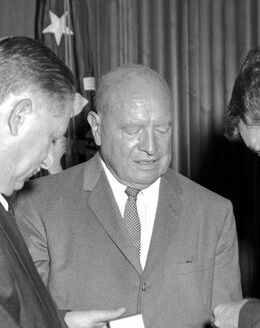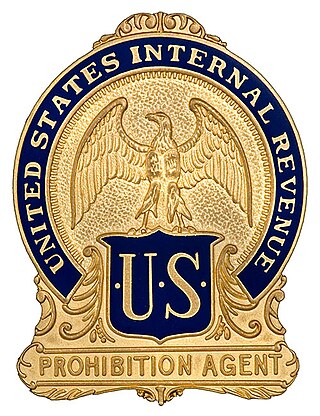Related Research Articles

The Harrison Narcotics Tax Act was a United States federal law that regulated and taxed the production, importation, and distribution of opiates and coca products. The act was proposed by Representative Francis Burton Harrison of New York and was approved on December 17, 1914.

The Marihuana Tax Act of 1937, Pub. L. 75–238, 50 Stat. 551, enacted August 2, 1937, was a United States Act that placed a tax on the sale of cannabis. The H.R. 6385 act was drafted by Harry Anslinger and introduced by Rep. Robert L. Doughton of North Carolina, on April 14, 1937. The Seventy-fifth United States Congress held hearings on April 27, 28, 29th, 30th, and May 4, 1937. Upon the congressional hearings confirmation, the H.R. 6385 act was redrafted as H.R. 6906 and introduced with House Report 792. The Act is referred to, using the modern spelling, as the 1937 Marijuana Tax Act. It was overturned in 1969 in Leary v. United States, and was repealed by Congress the next year.

Harry Jacob Anslinger was an American government official who served as the first commissioner of the U.S. Treasury Department's Federal Bureau of Narcotics during the presidencies of Herbert Hoover, Franklin D. Roosevelt, Harry S. Truman, Dwight D. Eisenhower, and John F. Kennedy. He was a supporter of Prohibition, and of the criminalization of all drugs except for alcohol, - because supporting the prohibition against alcohol means he didn’t support the criminalization of alcohol - and spearheaded anti-drug policy campaigns.

The Bureau of Prohibition was the United States federal law enforcement agency with the responsibility of investigating the possession, distribution, consumption, and trafficking of alcohol and alcoholic beverages in the United States of America during the Prohibition era. The enumerated enforcement powers of this organization were vested in the Volstead Act. Federal Prohibition Agents of the Bureau were commonly referred to by members of the public and the press of the day as "Prohis," or "Dry Agents." In the sparsely populated areas of the American west, agents were sometimes called "Prohibition Cowboys." At its peak, the Bureau employed 2,300 dry agents.

The war on drugs is the policy of a global campaign, led by the United States federal government, of drug prohibition, foreign assistance, and military intervention, with the aim of reducing the illegal drug trade in the US. The initiative includes a set of drug policies that are intended to discourage the production, distribution, and consumption of psychoactive drugs that the participating governments, through United Nations treaties, have made illegal.

The Bureau of Narcotics and Dangerous Drugs (BNDD) was a federal law enforcement agency within the United States Department of Justice with the enumerated power of investigating the consumption, trafficking, and distribution of narcotics and dangerous drugs. BNDD is the direct predecessor of the modern Drug Enforcement Administration (DEA).

The Federal Bureau of Narcotics (FBN) was an agency of the United States Department of the Treasury, with the enumerated powers of pursuing crimes related to the possession, distribution, and trafficking of listed narcotics including cannabis, opium, cocaine, and their derivatives. Headquartered in Washington, D.C., the FBN carried out operations and missions around the world. The bureau was in existence from its establishment in 1930 until its dissolution in 1968. FBN is considered a predecessor to the Drug Enforcement Administration.

Levi Gamble Nutt was the Chief of the Narcotics Division within the Prohibition Unit of the United States Department of the Treasury from 1919 to 1930, prior to the creation of the Federal Bureau of Narcotics (FBN). He was a registered pharmacist, and led the Division to the arrest of tens of thousands of drug addicts and dealers in the Prohibition era.

The Bureau of Drug Abuse Control (BDAC) was an American law enforcement agency that investigated the consumption, trafficking, and distribution of drugs and controlled substances. BDAC was a Bureau of the Food and Drug Administration (FDA). In the sum total of the two years that BDAC existed, it investigated and closed around 300 criminal cases, seized 43 clandestine drug laboratories, and made over 1,300 arrests.

Alfred Ray Lindesmith was an Indiana University professor of sociology. He was among the early scholars providing a rigorous and thoughtful account of the nature of addiction. He was a critic of legal prohibitions against addictive drugs, arguing that such prohibitions had adverse societal effects. Lindesmith's work in drug policy and addiction at Indiana U. was an element of progressivism, along with the landmark work of Alfred Kinsey and his associates at The Kinsey Institute, under the supervision of IU President Herman Wells.

In the United States, increased restrictions and labeling of cannabis as a poison began in many states from 1906 onward, and outright prohibitions began in the 1920s. By the mid-1930s cannabis was regulated as a drug in every state, including 35 states that adopted the Uniform State Narcotic Drug Act. The first national regulation was the Marihuana Tax Act of 1937.
A drug policy is the policy regarding the control and regulation of psychoactive substances, particularly those that are addictive or cause physical and mental dependence. While drug policies are generally implemented by governments, entities at all levels may have specific policies related to drugs.
The drug policy of Sweden is based on zero tolerance focusing on prevention, treatment, and control, aiming to reduce both the supply of and demand for illegal drugs. The general drug policy is supported by all major Swedish political parties with the exceptions of the Left Party – which advocates for the decriminalization of private consumption – and five of the seven major parties' youth wings.
The National Conference of Commissioners on Uniform State Laws developed the Uniform State Narcotic Drug Act in 1934 due to the lack of restrictions in the Harrison Act of 1914. The Harrison Act was a revenue-producing act and, while it provided penalties for violations, it did not give authority to the states to exercise police power regarding either seizure of drugs used in illicit trade or punishment of those responsible.

Henry Luke Giordano was an American pharmacist and federal agent who served as the second and last Commissioner of the Federal Bureau of Narcotics (FBN), from 1962 to 1968.
Robert Anderson was a Canadian filmmaker who specialized in films about psychiatry, first with the National Film Board of Canada, and then through his own company. He was the first filmmaker to create truthful, objective films about mental health and addiction, and to make films of this type using actual patients, doctors and hospitals, rather than actors in reconstructions. His most famous film is Drug Addict, which caused a furor when it was banned in the United States. Anderson was co-founder of the Canadian National Science Film Library, and he played a large role in bringing television to the Canadian House of Commons.

George Hunter White remains one of the most controversial federal agents in American history, and highly debated subject within law enforcement circles. A lifelong Federal Bureau of Narcotics (FBN) investigator, undercover operative, spymaster, World War II hero, one of the men responsible for the capture of Lucky Luciano, known for killing suspects, and known to have consumed most of the drugs he was chasing.

Garland H. Williams (1903–1993) was an American pioneer of covert investigations, military counterintelligence, white collar investigations, espionage, training and planning, and a lifelong law enforcement officer. He is a veteran of World War II and the Korean War. During World War II, Williams was integral in the training of thousands of American hopeful would-be undercover operatives and guerrilla fighters in both the Military Intelligence Division and the Office of Strategic Services.

Charles Siragusa, also known as "Charlie Cigars", was a lifelong special investigator, undercover operative, spymaster, and federal agent for the Federal Bureau of Narcotics, a precursor to the modern Drug Enforcement Administration. During World War II, he worked in North Africa for the Office of Strategic Services. He is perhaps best known today for his 30-year pursuit of the Italian-American gangster Lucky Luciano, but also pursued other criminal personalities in his career; escaped Nazis in South America, deviant Italian Catholic monks, Soviet Communist cocaine smuggling networks, and many others. In 1973, he played the role of himself in the film "Lucky Luciano." He is also remembered today as a facilitator and observer of the MKUltra experiments, managing the New York safehouses, eventually testifying before the United States Congress against members of his own agency and members of the Central Intelligence Agency.

John Haywood Finlator was an American federal administrator and narcotics law enforcement director. He was the first and only director of the Bureau of Drug Abuse Control (BDAC), and later served as deputy director of the Bureau of Narcotics and Dangerous Drugs (BNDD). He was one of the first members of the narcotics enforcement community that advocated for decriminalizing cannabis and marijuana. This advocacy often set him at odds with his coworkers at the bureau and with Congress but was praised by many medical community members.
References
- ↑ "Drug Addict, Film Record". onf-nfb.gc.ca. National Film Board of Canada. Retrieved 10 April 2023.
- ↑ "Drug Addict, Viewing Information". nfb.ca. National Film Board of Canada. Retrieved 10 April 2023.
- ↑ Anderson, Robert. "Personal Memoirs". dblack1713.tripod.com. D. Black. Retrieved 14 February 2023.
- ↑ Lindesmith, A.R. "Dope Fiend Mythology". northwestern.edu. Northwestern University. Retrieved 10 April 2023.
- ↑ Weibreb, Michael. "The Complicated Legacy of Harry Anslinger" (PDF). case.org. Council for Advancement and Support of Education. Retrieved 10 April 2023.
- ↑ "DRUG ADDICTION - CRIME OR DISEASE". ojp.gov. U.S. Department of Justice. Retrieved 14 February 2023.
- ↑ Galliher, John F; Keys, David P; Elsner, Michael. "Lindesmith v. Anslinger: An early government victory in the failed war on drugs". druglibrary.net. Journal of Criminal Law & Criminology. Retrieved 14 February 2023.
- ↑ Maria Topalovich, And the Genie Goes To...: Celebrating 50 Years of the Canadian Film Awards. Stoddart Publishing, 2000. ISBN 0-7737-3238-1.
- ↑ "Film in 1950". bafta.org. British Academy of Film and Television Arts. Retrieved 10 April 2023.